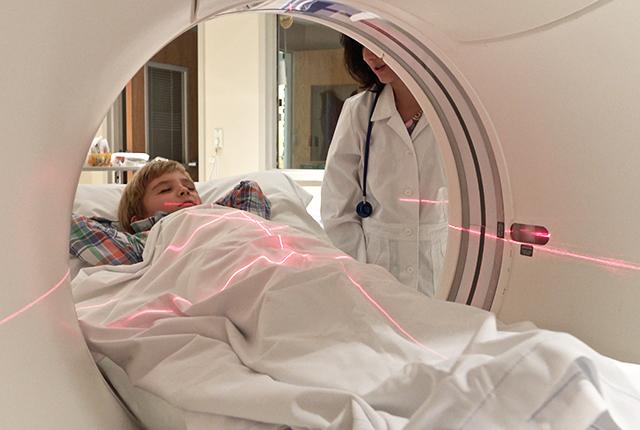
U.S. radiologists get new guidance on kids’ CT-scan doses
The information helps hospitals know whether their pediatric radiation doses are in the range of what's appropriate for common studies.
If you’re a parent of a child who needs a CT scan to diagnose a medical condition or injury, your concern is already ratcheted up. You don’t need additional worry about how much radiation is being transmitted to their body via a 360-degree computed tomography (CT) scan.
That’s the layman’s connection to new benchmarks that tell radiologists the median radiation dose, and range of doses, developed from 1.5 million pediatric CT scans performed across the nation. The findings identify appropriate radiation doses for pediatric studies of the head, abdomen and other anatomy.
“Taking care of pediatric patients and optimizing doses isn’t a new topic, but these are the first benchmarks that account for both a child’s size and age,” said Kalpana Kanal, a medical physicist and professor of radiology at the University of Washington School of Medicine.
She was lead author of the research paper, published in the journal Radiology, that identifies pediatric CT diagnostic reference levels. The levels were derived from scans performed over the past five years at community hospitals, academic medical centers, multispecialty clinics, freestanding centers, and dedicated children’s hospitals.
Kanal and colleagues analyzed data from the American College of Radiology’s Dose Index Registry, an archive of millions of image-study doses logged, de-identified and shared by hospitals.
“One interesting finding was that 57% of our data came from community hospitals, many of which likely don’t have a full-time pediatric radiologist or medical physicist on staff to help with dose-optimizing,” she said. “These guidelines help you dial up or dial down your dose if you don’t have those resources.”
The volume of data alone gives the new reference levels statistical strength beyond what was previously available for the pediatric (to age 18) population, she added.
Dr. Randy Otto, director of pediatric radiology at Seattle Children’s and a UW associate professor of radiology, said the new diagnostic reference levels have comparative value.
“You can see if more or most other hospitals are getting the images they need at lower, or higher, doses. This study gives you an idea of what other hospitals are achieving and can motivate you to try to get lower if your hospital’s dose indices are on the high end of the range,” Otto said.
It is also the case that radiation doses can be too low, such that the resulting CT scan has too little contrast to be of diagnostic value – akin to an underexposed picture.
“Any radiation is too much if the study’s not diagnostic,” Otto added. “You have to use enough dose to get a useful result. That’s why these new reference levels really help radiologists understand the range they’re functioning in, and how they can do better.”
For any CT study, hospitals’ doses should be between the 25th and 75th percentile, close to the median. Doses should be investigated if they are above the 75th percentile or below the 25th percentile, Kanal said.
For details about UW Medicine, please visit https://uwmedicine.org/about.